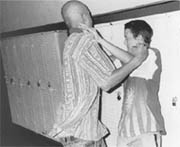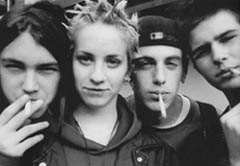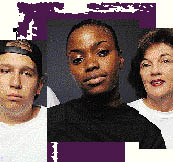|
 It was a clear,
cool evening on Saturday, September 30, 1972, when Twinkle Rudberg,
BA'56, and her husband Daniel left their Westmount home together for
the last time. They were driving to have dinner with friends in downtown
Montreal when they saw a barefoot boy leap from the back seat of a parked
car and assault an elderly woman. It was a clear,
cool evening on Saturday, September 30, 1972, when Twinkle Rudberg,
BA'56, and her husband Daniel left their Westmount home together for
the last time. They were driving to have dinner with friends in downtown
Montreal when they saw a barefoot boy leap from the back seat of a parked
car and assault an elderly woman.
Daniel Rudberg stopped their car, jumped out and helped the dazed victim
to her feet. Then he chased the 14-year-old purse snatcher into some
nearby bushes. The two struggled, the teen pulled out a knife and within
minutes, Daniel Rudberg - husband, father, good samaritan - was dead.
He was 38.
Twinkle Rudberg thought her own life had ended. She was very angry
about what had happened, but, surprisingly, not at the lonely boy who
had killed her husband. During the teen's preliminary hearing and trial,
she learned that he was from a broken home, had turned to drugs, joined
a gang and run away from his home in the United States before coming
to Montreal. His violent act was apparently in imitation of something
he had seen on television. "The boy who murdered my husband was also
a victim," she says. Despite her shock and pain, she quickly realized
that she had a choice to make: she could either live the rest of her
life as a victim or use her newfound awareness of the devastating impact
of youth violence to try to spare others from the anguish. For her,
prevention was the only answer. "Otherwise what happened to me was without
meaning," she says. "Taking a hard line doesn't solve anything. It doesn't
benefit humanity." So she set up the Daniel Rudberg Fund for  research
into adolescent and child psychiatry soon after her husband's death.
She credits her "very strong (99-year-old) mother" for raising her to
deal with difficult situations and then keep going. research
into adolescent and child psychiatry soon after her husband's death.
She credits her "very strong (99-year-old) mother" for raising her to
deal with difficult situations and then keep going.
"I think that was part of my upbringing, to move on," Rudberg says.
And she did move on, but it was 20 years before she was finally able
to speak publicly about her husband's murder for the first time. She
was touched by the actions of 13-year-old Quebecer Virginie Larivière,
who in 1992 launched a campaign against violence on television after
her sister was raped and strangled. And that encouraged Rudberg to break
her own silence. Her story appeared on the front page of the Montreal
Gazette on September 30, 1992. She discovered, however, that talking
about the impact of violence wasn't enough.
|
Dim Light
Dim light alone
in the darkness
rattled by the screams
of terror echoing from the
silence that surrounds.
A crashing sound of dishes
shatters his nerves,
cracking the glass case
that contains the light
of his soul and
losing all hope he buries
his head in his pillow,
knowing that nothing
will save him.
|
"Dan's murder was influenced by a television program," Rudberg says.
"But I realized I was fighting a giant and I didn't want to become an
activist because it wasn't helping the kids." So she founded Leave Out
ViolencE (L.O.V.E.) in 1993. Each year about 20 teenagers aged 13-21
who are either victims or perpetrators of violence are recruited from
Montreal schools or referred by social workers, counsellors or teachers
to participate in the group's twice-weekly, after-school photojournalism
program. Held at Dawson College, it brings together teenage victims
of violence, perpetrators and witnesses to examine the causes of violence,
its impact and how to prevent it.
Recent incidents like the murder in November 1997 of Victoria teenager
Reena Virk and the shootings in Littleton, Colorado, and Taber, Alberta,
have focused public attention on the growing problem of youth violence,
and many are pointing a finger at violent television as a major culprit.
That's too simplistic, says Dr. Klaus Minde, DipPsych'65, psychiatrist-in-chief
of the Montreal Children's Hospital. "We should not imagine that having
less violence on television will do away with all kinds of social ills,"
he warns. What teens really need, he adds, is a place where they are
listened to, their opinions are valued and they can be taught appropriate
ways to handle conflict and anger.
If they aren't getting that at home, there are few other places where
they can. According to the Canadian Coalition for the Rights of the
Child, 70% of the funds that the Canadian government gives to the provinces
for youth justice is spent on custody. With rising public demand for
tougher penalties for young offenders it's likely that even less money
will be available to spend on prevention programs or alternative approaches.
Minde says being attracted to violent television is a manifestation
of a problem, not the cause of it. "The tendency of children who are
unhappy and angry is to select television programs that fit their own
inner life and they see it as a guide for their own behaviour."
 Factors
that can contribute to children's unhappiness and anger include child
abuse, neglect, exposure to violence at home, poor parental care or
lack of social skills, Minde says. He described studies where young
subjects are shown a videotape depicting two children helping each other,
a second one with a neutral situation and a third one where two kids
are angry. Most children can correctly identify what is happening in
each of the three videos, says Minde. However, subjects with violent
tendencies perceive neutral situations as a prelude to a fight and believe
that they therefore have to act first. "They have a distorted view of
what the world is about and don't see things as they really are," Minde
explains. When a problem arises, they are reluctant to make any compromises
because they believe that "if I give a little bit he will take everything
and I will have nothing." Factors
that can contribute to children's unhappiness and anger include child
abuse, neglect, exposure to violence at home, poor parental care or
lack of social skills, Minde says. He described studies where young
subjects are shown a videotape depicting two children helping each other,
a second one with a neutral situation and a third one where two kids
are angry. Most children can correctly identify what is happening in
each of the three videos, says Minde. However, subjects with violent
tendencies perceive neutral situations as a prelude to a fight and believe
that they therefore have to act first. "They have a distorted view of
what the world is about and don't see things as they really are," Minde
explains. When a problem arises, they are reluctant to make any compromises
because they believe that "if I give a little bit he will take everything
and I will have nothing."
Participants in the L.O.V.E. program are given the opportunity to speak
out about violence in their lives, says Dawson College photography instructor
Stan Chase. "We give them a place to deal with their experiences through
writing and taking pictures." While one group of teens spends time learning
photography with Chase, the other works on their writing with program
director and Concordia University journalism professor Brenda Zosky
Proulx. It's here that teens write powerful stories about the violence
that surrounds them. "Sitting on the floor, surrounded by light, or
next to the photo lab is where some of the best writing happens," Proulx
says.
By the end of the year participants are able to take pictures, develop
film and print contact sheets, Chase says. "They're usually doing the
same work as a first-year college student," he observes. "These are
kids that are labelled underachievers, but when you see what they produce
for us, they're definitely not underachievers." The result is L.O.V.E.
Works! a poignant collection of photographs, essays and poems by 58
teens from the program's photojournalism project. Edited by Proulx and
released by Stoddart Publishing Co. in 1998, it's dedicated to the memory
of Daniel Rudberg and to youth who are affected by violence on a daily
basis.
 Julia, 19,
who joined L.O.V.E. about three years ago, was one of those young people.
She had been placed in a group home after rebelling, frequently running
away from her family, stealing a car and doing drugs. She was raped
at the age of 14 by an acquaintance at whose home she had sought refuge.
It was within the accepting and respectful environment of L.O.V.E. that
Julia was able to turn her life around. "I would drag my feet going
home," she recalls. Today, the affable blonde lives with her family
and credits the program and having found God for setting her straight.
Now she spreads the gospel about L.O.V.E. and the effects of violence
on society to students at Montreal schools as part of the organization's
outreach team. Julia, 19,
who joined L.O.V.E. about three years ago, was one of those young people.
She had been placed in a group home after rebelling, frequently running
away from her family, stealing a car and doing drugs. She was raped
at the age of 14 by an acquaintance at whose home she had sought refuge.
It was within the accepting and respectful environment of L.O.V.E. that
Julia was able to turn her life around. "I would drag my feet going
home," she recalls. Today, the affable blonde lives with her family
and credits the program and having found God for setting her straight.
Now she spreads the gospel about L.O.V.E. and the effects of violence
on society to students at Montreal schools as part of the organization's
outreach team.
Accompanied by staff member Maureen Labreche, teams of four students
visit the same classroom three times over a one- to two-week period.
During the first session they talk about L.O.V.E., show students 20-25
photographs taken by participants in the photography program and discuss
their significance. Then team members share their own experiences. "It's
so powerful that there's not a dry eye in the house afterwards," Labreche
says. "That's why this program works."
| Alone
They shout,
She cries.
They call her names,
She cries.
No one knows why.
She goes to school
and puts on a show,
They think she's happy
but nobody knows.
She goes back home
and feels so low
and all alone
Nobody knows.
It's time for bed,
and nobody knows.
Nobody knows.
Nobody knows.
|
The key to its success goes beyond the power of the message. It's the
messenger who really matters. Julia thinks that having teens talking
to teens makes a big difference. "It's the first time students see people
their own age rather than adults condescendingly talking about violence,"
she says. Daniel Guinta, 16, agrees. He joined Leave Out ViolencE a
year ago after participants came to speak at his school. "I could relate
to them because they were my age," he says. Six months later, the articulate
high school student joined the outreach team.
The second visit focuses on writings about violence. Labreche writes
some unfinished sentences on the blackboard to encourage students to
write about their own experiences with violence. They include "I am
worried about violence because I remember when..." and "We are having
trouble with youth violence because we don't...." Elementary school
students can also opt to write a letter to their parents. "Sometimes
I die inside from the things I read," Labreche says. "They have experienced
a lot of violence in their families." Students can be put in touch with
support services, if they are interested in getting help.
For the final session, students listen to some popular music, mostly
rap, to discuss the violent lyrics the songs contain. They are also
shown a video about the level of violence displayed in the media. Then
students are invited to join L.O.V.E.
The seeds of Twinkle Rudberg's philosophy about handling tragedy are
perhaps evident in the quote she chose for her entry in the Old McGill
yearbook. "The mind is its own place and in itself can make a heav'n
of hell, a hell of heav'n." When asked if she recalled why she had chosen
that particular passage, she responds with a puzzled "I have no idea,"
but she recognizes an eerie connection between the words from Milton's
Paradise Lost and the work she is now doing. "I chose to take something
that happened to me that was hell and turn it into something positive - and we're doing the same thing with kids," she
says. Starting in January, she will be able to extend the photojournalism
project to youth in Halifax and Vancouver, thanks to a $1 million grant
from the Millennium Bureau of Canada. "Our millennium project is to
have 2,000 L.O.V.E. youth across Canada be spokespeople for the elimination
of youth violence," Rudberg says. A franco-phone program was launched
in Montreal this summer and one has been operating in Toronto since
1997. But Rudberg doesn't plan to stop there. She says the shootings
in Colorado and Alberta have made her more determined than ever to make
Leave Out ViolencE available to as many teens as possible. It is important
to empower young people, she says, for it is they who will provide the
answers to stemming the tide of youth violence. "I don't think adults
alone can make a difference here. We have to listen to our youth and
let them tell us what has to be done."
something positive - and we're doing the same thing with kids," she
says. Starting in January, she will be able to extend the photojournalism
project to youth in Halifax and Vancouver, thanks to a $1 million grant
from the Millennium Bureau of Canada. "Our millennium project is to
have 2,000 L.O.V.E. youth across Canada be spokespeople for the elimination
of youth violence," Rudberg says. A franco-phone program was launched
in Montreal this summer and one has been operating in Toronto since
1997. But Rudberg doesn't plan to stop there. She says the shootings
in Colorado and Alberta have made her more determined than ever to make
Leave Out ViolencE available to as many teens as possible. It is important
to empower young people, she says, for it is they who will provide the
answers to stemming the tide of youth violence. "I don't think adults
alone can make a difference here. We have to listen to our youth and
let them tell us what has to be done."
|
The Jacket
It was late at night when I lost my best friend,
my world. Clifford, a high school drop-out who was trying to support
his mother due to his father's death three weeks earlier, was
on his way to his car to go home when he was brutally slaughtered.
When his body was found, he had been stabbed 16
times in and around the heart. His own mother could not even recognize
him due to the bruises covering his face. She noticed that he
wasn't wearing his jacket. When I got the phone call, I felt as
if my soul had been ripped out of me and sent to a far-off place
where I could never find it again and I haven't, nor will I ever.
Eventually a confession was made. The perpetrator
said, "I wanted his jacket. I didn't mean to kill him." I cannot
seem to understand why or how, but this is a problem in our society,
and I will contribute all of myself and all within my power to
make a difference.
|
|